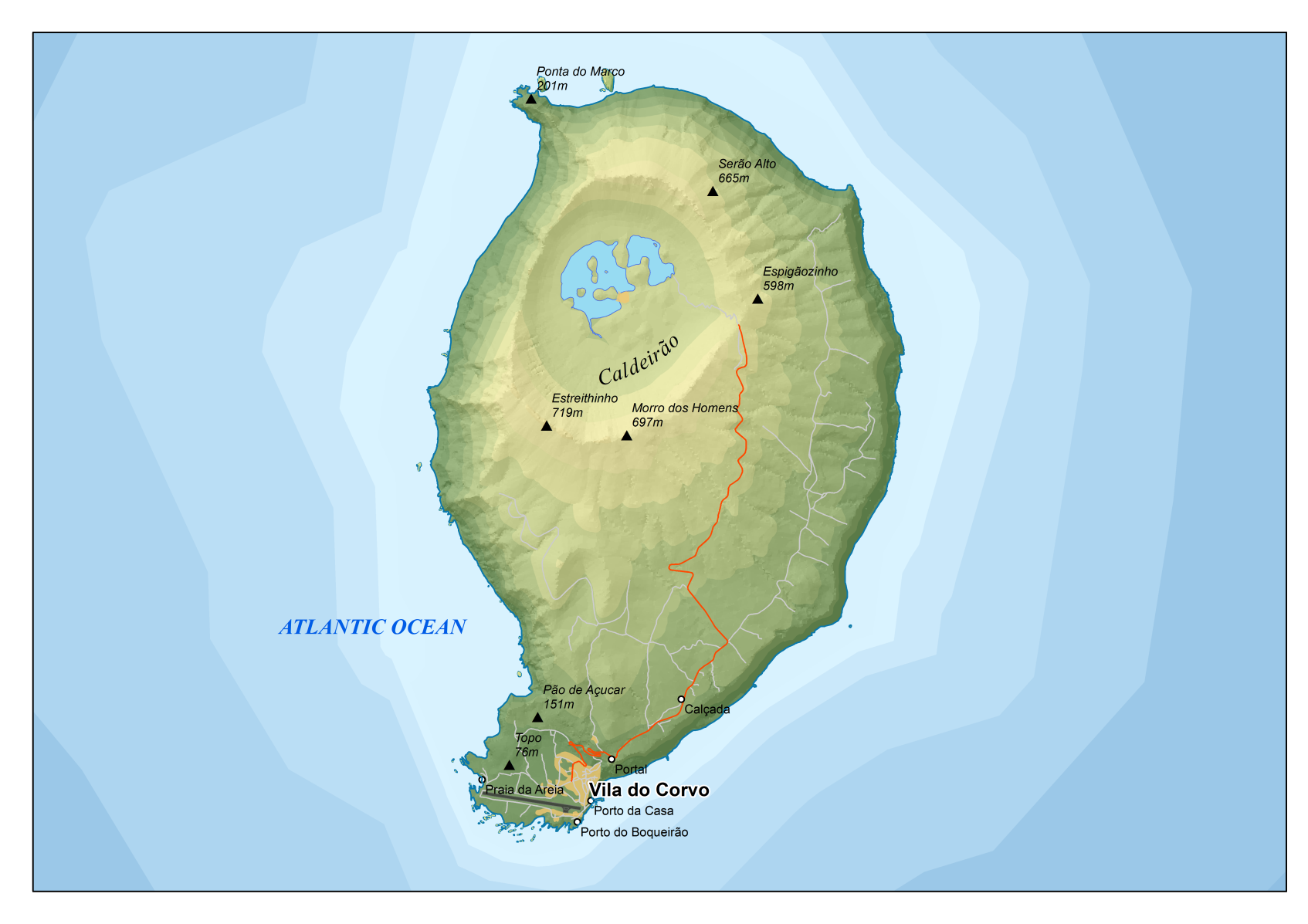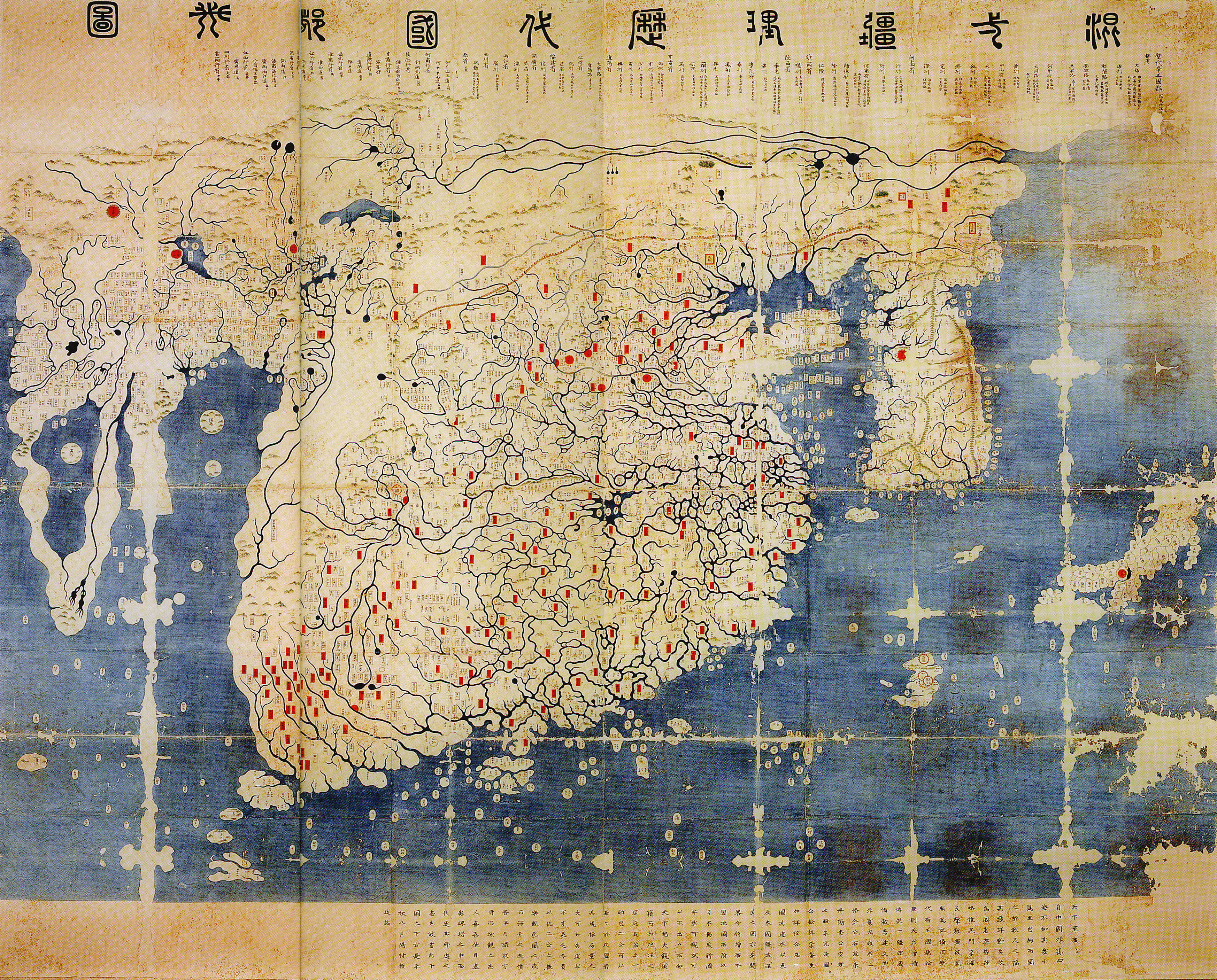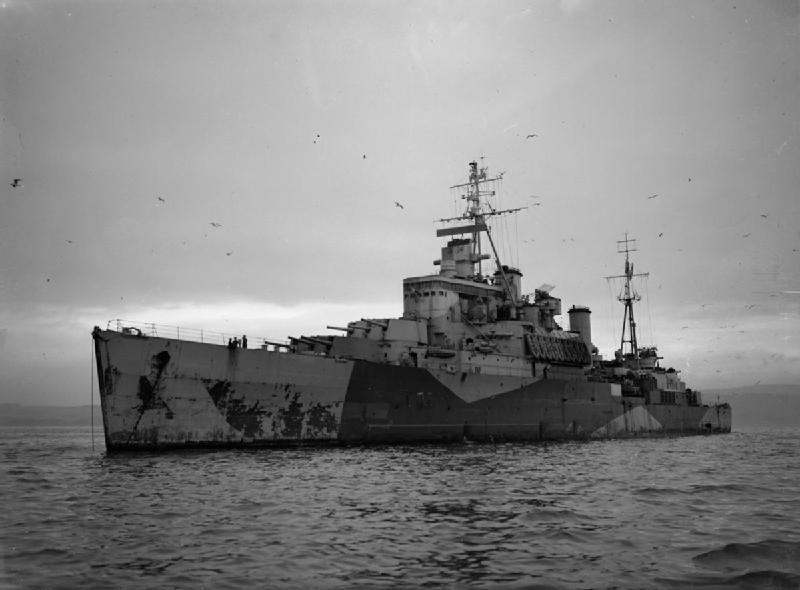|
Statue Of Corvo
The statue of Corvo was an equestrian statue which, according to Portuguese chronicles, was discovered on the Corvo Island, island of Corvo by the first Portuguese explorers of the Azores. The statue was made of stone and was destroyed in the late 15th or early 16th century, as a result of a failed attempt to transport it to Portugal. Description The statue was described by Damião de Góis as being in stone and standing on a slab. It depicted a man riding a horse. The man was pointing towards the west, his right arm and index finger outstretched, while his left rested on the horse's mane. The man wore a moorish tunic but no hat. Its plinth was inscribed with worn letters in an alphabet which was unknown to the early modern sailors who visited the island. The statue was located on the northwestern side of Corvo's mountain, in a location which de Góis describes as dangerous to access. The area was so inaccessible that in their attempts to take copies of the writing on the plin ... [...More Info...] [...Related Items...] OR: [Wikipedia] [Google] [Baidu] |
Corvo Area Map-en
Corvo is the Italian, Portuguese, and Galician word for ''crow'', and may refer to: Places * Rio Corvo, a tributary of the Ceira River in the Serra do Acor, Portugal * Corvo Island * Corvo (Azores), the only municipality on the island of Corvo * Corvo Airport, airport for Vila do Corvo * Corvo, Cape Verde * Corvo, Italy Other *Corvo (surname) * Corvo (knife), a type of curved blade from Chile * Corvo Attano, fictional character in ''Dishonored'' * ''Il corvo'' (1761), a play by Carlo Gozzi * Willys FAMAE Corvo, or simply Corvo, a Chilean military vehicle * Corvos, a Portuguese band * Sypaq Corvo, a brand of drone See also * Pontecorvo (other), including Ponte Corvo * Corvus (other) * Cuervo (other) {{disambiguation, geo ... [...More Info...] [...Related Items...] OR: [Wikipedia] [Google] [Baidu] |
Ba'al Hammon
Baal Hammon, properly Baʿal Ḥamon ( Phoenician and ), meaning "Lord Hammon", was the chief god of ancient Carthage. He was a weather god considered responsible for the fertility of vegetation and esteemed as king of the gods. He was depicted as a bearded older man with curling ram's horns. Baʿal Ḥammon's female cult partner was Tanit. Etymology He is identified as one of the Phoenician deities covered under the name of Baal. However, the meaning of his second name is unclear. Frank Moore Cross argued for a connection to ''Hamōn'', the Ugaritic name for Mount Amanus, a peak in the Nur Mountains that separate Syria from Cilicia. In the 19th century, when Ernest Renan excavated the ruins of Ḥammon, now Umm al-Amad, between Tyre and Acre, he found two Phoenician inscriptions dedicated to El-Ḥammon. Others have proposed Ḥammon as a syncretic association with Amun, the god of ancient Libya, In Siwa Oasis, a solitary oracle of Amun remained near the Libyan Desert, wh ... [...More Info...] [...Related Items...] OR: [Wikipedia] [Google] [Baidu] |
Lost Sculptures
Lost or LOST may refer to getting lost, or to: Arts, entertainment, and media Television * ''Lost'' (TV series), a 2004 American drama series about people who become stranded on a mysterious island * ''Lost'' (2001 TV series), a short-lived American and UK reality series * ''Lost'' (South Korean TV series), a 2021 South Korean series * "Lost" (''The Bill''), a 1985 episode * "Lost" (''Stargate Universe''), an episode of science fiction series ''Stargate Universe'' *"Lost", an episode of ''Unleashed!'' *"Lost", an episode of the Canadian documentary TV series ''Mayday'' *"Lost", an episode of Disney's ''So Weird'' * "The Lost" (''Class''), an episode of the first series of the ''Doctor Who'' spin-off series ''Class'' Films * ''Lost'' (1950 film), a Mexican film directed by Fernando A. Rivero * ''Lost'' (1956 film), a British thriller starring David Farrar * ''Lost'' (1983 film), an American film directed by Al Adamson * ''Lost!'' (film), a 1986 Canadian film directed by Peter R ... [...More Info...] [...Related Items...] OR: [Wikipedia] [Google] [Baidu] |
History Of The Azores
The following article describes the history of the Azores, an archipelago composed of nine volcanic islands in the Macaronesia region of the North Atlantic Ocean, about west of Lisbon, about northwest of Morocco, and about southeast of Newfoundland, Canada. Myth and legend Stories of islands in the Atlantic Ocean, legendary and otherwise, had been reported since classical antiquity. Utopian tales of the Fortunate Isles (or Isles of the Blest) were sung by the poets Homer, Horace, and Pindar. Plato articulated the legend of Atlantis. Ancient writers such as Plutarch, Strabo and, more explicitly, Pliny the Elder and Ptolemy, testified to the real existence of the Canary Islands. The Middle Ages saw the emergence of a new set of legends about islands deep in the Atlantic Ocean. These were sourced in various places, e.g. the Irish ''immrama'', or missionary sailing voyages (such as the tales of Ui Corra and Saint Brendan) and the sagas of Norse adventurers (such as the Grœn ... [...More Info...] [...Related Items...] OR: [Wikipedia] [Google] [Baidu] |
Rampin Rider
The ''Rampin Rider'' or ''Rampin Horseman'' ( 550 BC) is an equestrian statue from the Archaic Period of Ancient Greece. It is made of marble, and has traces of red and black paint. The head of the rider was found on the Acropolis of Athens in 1877 and donated to the Louvre. Parts of the body of the rider and horse were found ten years earlier in a ''Perserschutt'' ditch filled with statues broken during the 480 BC Persian sack of Athens. The head was not associated with the rest of the statue until 1936. The statue is displayed with a plaster cast of the head at the Acropolis Museum, while the head remains at the Louvre where it is displayed with a cast of the rest of the statue. The rider has many of the features typical of an Archaic kouros, but has several asymmetrical features that break with the period's conventions. Interpretations The statue was originally thought to be a part of a set of statues, perhaps paired with another as a mounted presentation of Castor and Pol ... [...More Info...] [...Related Items...] OR: [Wikipedia] [Google] [Baidu] |
Gangnido
The Honil Gangni Yeokdae Gukdo Ji Do ("Map of Integrated Lands and Regions of Historical Countries and Capitals (of China)"Kenneth R. Robinso Choson Korea in the Ryukoku Kangnidoin ''Imago Mundi'', Vol. 59 No. 2 (June 2007) pp. 177–192, via Ingenta Connect.), often abbreviated as Kangnido, is a world map completed by the Korean scholars Kwon Kun and Yi Hoe in 1402, during the Joseon dynasty.Cartography of Korea, pgs. 235–345, Gari Ledyard ''al''., (Department of Geography, University of Wisconsin, Madison), The History of Cartography, Volume Two, Book Two, Cartography in Cartography in the Traditional East and Southeast Asian Societies, 1994, The University of Chicago Press, J. B. Harley and David Woodward ''ed''., (Department of Geography, University of Wisconsin, Milwaukee, WI / Department of Geography, University of Wisconsin, Madison, WI), pgs. slip cover, 243–247, . It is notably the oldest extant Korean world map, with two known copies that are both currently located i ... [...More Info...] [...Related Items...] OR: [Wikipedia] [Google] [Baidu] |
Yongle Emperor
The Yongle Emperor (2 May 1360 – 12 August 1424), also known by his temple name as the Emperor Chengzu of Ming, personal name Zhu Di, was the third List of emperors of the Ming dynasty, emperor of the Ming dynasty, reigning from 1402 to 1424. He was the fourth son of the Hongwu Emperor, the founding emperor of the dynasty. In 1370, Zhu Di was granted the title of Prince of Yan. By 1380, he had relocated to Beijing and was responsible for protecting the northeastern borderlands. In the 1380s and 1390s, he proved himself to be a skilled military leader, gaining popularity among soldiers and achieving success as a statesman. In 1399, he rebelled against his nephew, the Jianwen Emperor, and launched a civil war known as the Jingnan campaign, or the campaign to clear away disorders. After three years of intense fighting, he emerged victorious and declared himself emperor in 1402. After ascending the throne, he adopted the Chinese era name, era name Yongle, which means "perpetual ... [...More Info...] [...Related Items...] OR: [Wikipedia] [Google] [Baidu] |
Pseudohistory
Pseudohistory is a form of pseudoscholarship that attempts to distort or misrepresent the historical record, often by employing methods resembling those used in scholarly historical research. The related term cryptohistory is applied to pseudohistory derived from the superstitions intrinsic to occultism. Pseudohistory is related to pseudoscience and pseudoarchaeology, and usage of the terms may occasionally overlap. Although pseudohistory comes in many forms, scholars have identified common features in pseudohistorical works. Pseudohistory is almost always motivated by a contemporary political, religious, or personal agenda. It frequently presents sensational claims or a big lie about historical facts which would require unwarranted revision of the historical record. Another hallmark is an underlying premise that scholars have a furtive agenda to suppress the promoter's thesis—a premise commonly corroborated by elaborate conspiracy theories. Works of pseudohistory often ... [...More Info...] [...Related Items...] OR: [Wikipedia] [Google] [Baidu] |
Gavin Menzies
Rowan Gavin Paton Menzies (14 August 1937 – 12 April 2020) was a British submarine lieutenant-commander who authored books claiming that the Chinese sailed to America before Columbus. Historians have rejected Menzies' theories and assertions and have categorised his work as pseudohistory. He was best known for his controversial book ''1421: The Year China Discovered the World'', in which he asserts that the fleets of Chinese Admiral Zheng He visited the Americas prior to European explorer Christopher Columbus in 1492, and that the same fleet circumnavigated the globe a century before the expedition of Ferdinand Magellan. Menzies' second book, ''1434: The Year a Magnificent Chinese Fleet Sailed to Italy and Ignited the Renaissance'', extended his discovery hypothesis to the European continent. In his third book, ''The Lost Empire of Atlantis'', Menzies claims that Atlantis did exist, in the form of the Minoan civilization, and that it maintained a global seaborne empire ext ... [...More Info...] [...Related Items...] OR: [Wikipedia] [Google] [Baidu] |
Domenico And Francesco Pizzigano
Domenico and Francesco Pizzigano, known as the Pizzigani brothers, were 14th-century Venetian cartographers. Their surname is sometimes given as Pizigano (only one 'z') in older sources. 1367 chart ] The Pizzigani brothers are principally known for the construction of a portolan chart, signed and dated 1367, currently held by the Biblioteca Palatina of Parma (Ms.Parm.1612). Measuring 138 by 92 cm, it is one of the largest maps of that era. There is some controversy over the authorship. The note on the edge of the map, states (in one reading): ""MCCCLXVII. Hoc opus compoxuid franciscus pizigano veneciar et domnus pizigano In Venexia meffecit marcus die XII decembris.". The common assumption is that this refers to two brothers, Francesco Pizzigano and Domenico Pizzigano. Among the various alternative hypothesis is that Francesco was the son of Domenico, rather than his brother (and that Domenico might be dead by this date); that 'domnus' is a title for a priest, that th ... [...More Info...] [...Related Items...] OR: [Wikipedia] [Google] [Baidu] |
Cyrene, Libya
Cyrene, also sometimes anglicization of names, anglicized as Kyrene, was an ancient Greeks, ancient Greek Greek colonization, colony and ancient Romans, Roman Cities of the Roman Empire, city near present-day Shahhat in northeastern Libya in North Africa. It was part of the Pentapolis (North Africa), Pentapolis, an important group of five cities in the region, and gave the area its classical and early modern name Cyrenaica. Cyrene lies on a ridge of the Jebel Akhdar (Libya), Jebel Akhdar uplands. The archaeological remains cover several hectares and include several monumental temples, stoas, theatres, bathhouses, churches, and palatial residences. The city is surrounded by the Necropolis of Cyrene. Since 1982, it has been a UNESCO World Heritage Site. The city's port was Apollonia, Cyrenaica, Apollonia (Marsa Sousa), located about to the north. The city was attributed to Apollo and the legendary etymology, etymon Cyrene (mythology), Cyrene by the Greeks themselves but it was p ... [...More Info...] [...Related Items...] OR: [Wikipedia] [Google] [Baidu] |
Johan Frans Podolyn
Johan Frans Podolyn or Johann Franz Podolyn (Lisbon 29 May 1739 - Gothenburg 29 May 1784)"Johan Frans Podolijn", Emil Hildebrand, ''Minnespenningar öfver enskilda svenska män och qvinnor'', Stockholm : Kongl. Witterhets Historie och Antiqvitets Akademiens Förlag, 1860, OCLC 457966652p. 207 was a Swedish numismatist who published on Punic currency in his possession which had been found on the island of Corvo in the Azores. He wrote about the discovery in 1778 in a Swedish academic publication now known as the Publications of the Royal Society of Sciences and Letters in Gothenburg, presumably indicating that he was a member of the society. Podolyn was the son of a Swedish merchant and Vice-Consul. He had a gift for languages and worked for the Alströmer family, accompanying them on voyages in addition to working as a bookkeeper in Gothenburg and Alingsås Alingsås () is a urban areas of Sweden, locality and the seat of Alingsås Municipality in Västra Götaland County, Swede ... [...More Info...] [...Related Items...] OR: [Wikipedia] [Google] [Baidu] |






